
Kevin Gray
Chief Investment Officer
![]() 5 min read
5 min read
Long Rates Volatility
Black Swan
‘If I were only casting the White Swan, she would be yours. But I’m not.’ Thomas Leroy, Black Swan
‘Never think that lack of variability is stability. Don’t confuse lack of volatility with stability, ever.’ Nassim Nicholas Taleb
‘Let me explain something to you, moron, ok? Swan killers leave. People who aren’t swan killers stay, have a little lunch, enjoy themselves, get to know the members. There is nothing wrong. Get it?!’ Larry David, Curb Your Enthusiasm – The Black Swan

Volatility is something familiar to all investors. It is somewhat akin to a distant relative at Christmas, often going unnoticed until *insert political conversation* causes an almighty eruption and ruins the day. The tendency for its spikes to coincide with large equity drawdowns has given it a bad reputation.
However, volatility itself is an alternative beta, a source of risk and return that can be isolated and invested in, and in the right hands it is an incredibly useful tool that fits into a number of different investment objectives, depending on the type of volatility exposure one takes.
The most established and widely recognised gauge of equity volatility is the VIX, which is constructed using implied volatilities of S&P 500 options. Sadly, as derivative geeks, much of our lives revolve around curves, and it is the typical term structure of the VIX that gives rise to the most popular risk premia trade there is, selling short-term US equity volatility:
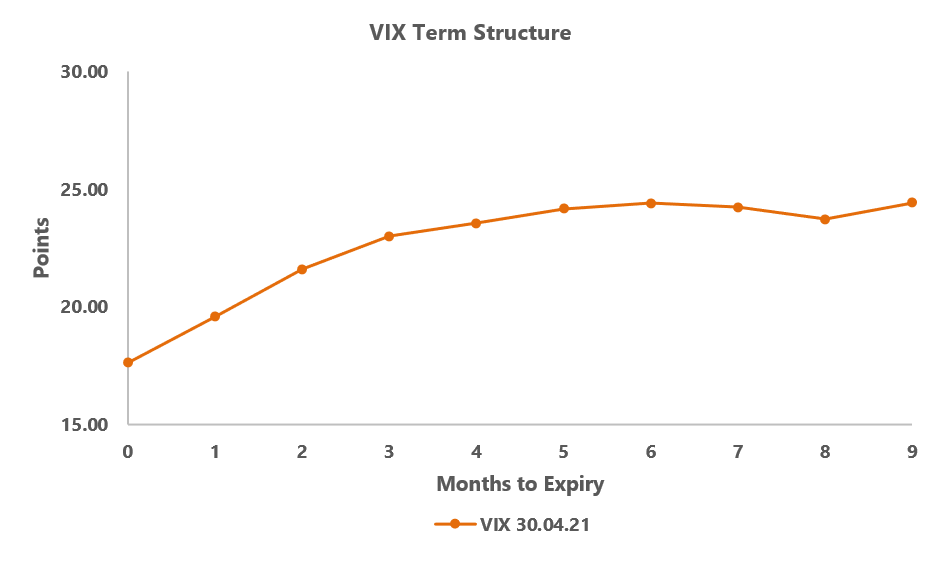
The short end (0-9m) of the VIX term structure is typically upward sloping, or contangoed, reflecting the greater perceived uncertainty the further out into the future one goes. Short-term short volatility strategies monetise the fact that in general this increased fear tends not to manifest itself in realised adverse events. Therefore, selling volatility out at 9 months can allow the seller to ‘roll-down’ and earn a premium. The steeper the contango, the more premium that can be earnt. Currently the VIX is in steep contango.
However, curve strategies in general are susceptible to shifts in curve shape, and short volatility strategies are no different. Sellers of short term volatility will suffer in particular when there are spikes in volatility at the front end to which they are exposed – see March 2020 as an example:
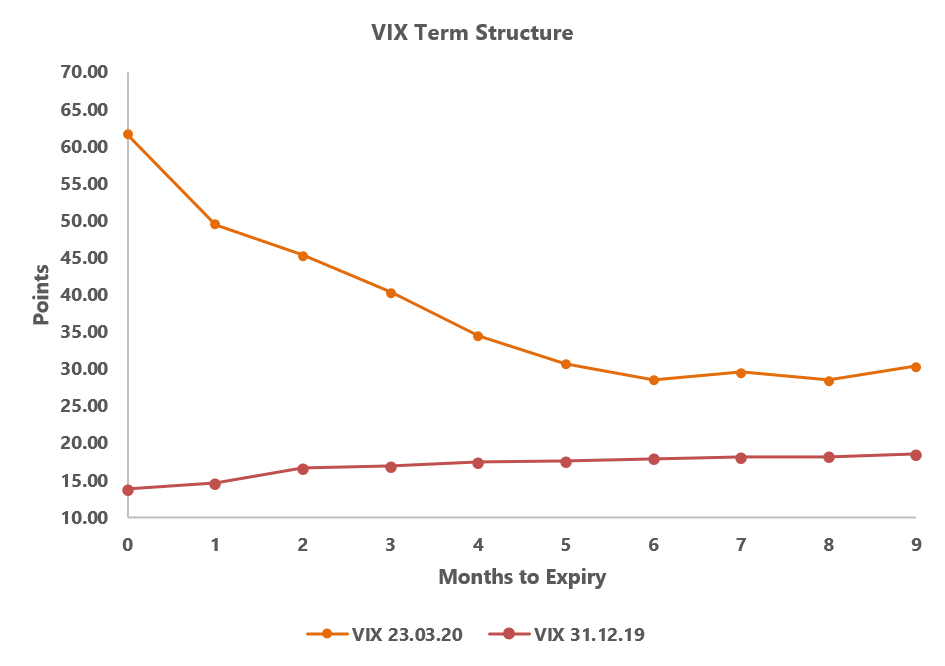
Short-term volatility spikes tend to occur when risk assets also suffer for obvious reason. Moves tend to be sharp and severe, which is why selling short-term volatility has been accused of being akin to ‘picking up pennies in front of a steamroller.’ Incidentally, this is why many alternative strategies tend to become highly correlated in times of crisis; the allure of the persistent returns that selling short-term equity volatility has had historically is too tempting to forgo in order to maintain an uncorrelated nature; too many managers only cast for the White Swan – and that change in the term structure would have had a very pronounced effect on any strategy aiming to be uncorrelated while selling short term equity volatility:

Source: Fortem Capital, Bloomberg
For volatility sellers, a way to control for those vicious spikes at the front end of the curve is to sell further out, exactly as structured product funds such as the Fortem Capital Progressive Growth Fund do. Further out, beyond the expiries that the VIX generally tracks, the curve is less reactive, and investors are less exposed. In addition, the PGF has the added benefit of in-built protection in the form of the conservative setting of barriers as well as a Diversifier Portfolio with a long volatility bias:
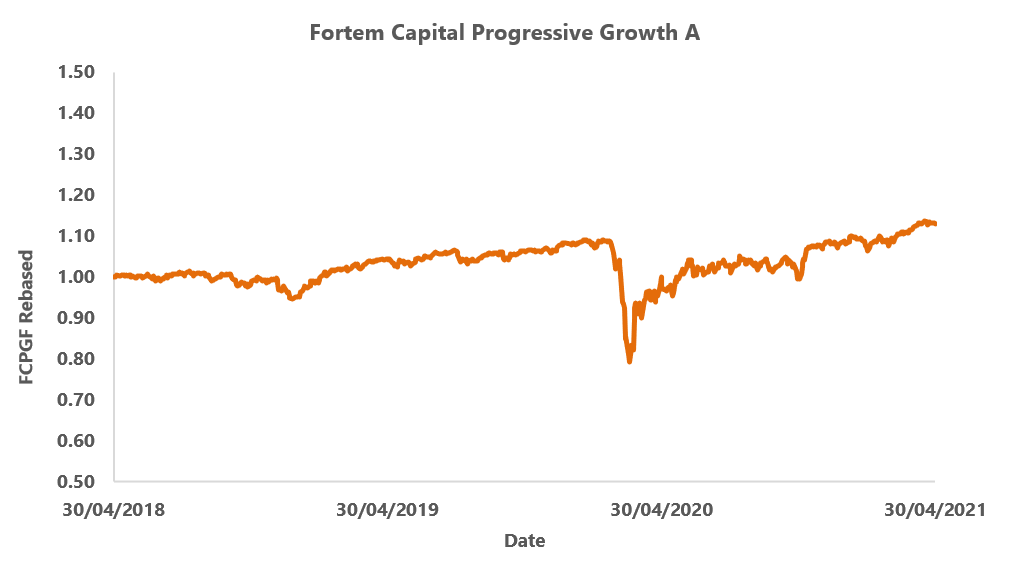
Source: Fortem Capital, Bloomberg
However, for any alternative fund that seeks to be uncorrelated to risk assets including equity, clearly selling short-term volatility is inappropriate (even though most do), as an alternative fund should cast for the Black Swan. Given that selling short-term equity volatility leaves one particularly vulnerable to big spikes in short-term volatility, then it might make sense to assume that long equity volatility strategies will give a defensive profile from which one should benefit in a Black Swan event. But, being long equity volatility is effectively funding the short trade and paying that premium that the sellers are harvesting, and with the VIX term structure as it is currently, and indeed tends to be, one might bleed to death waiting for their crisis:
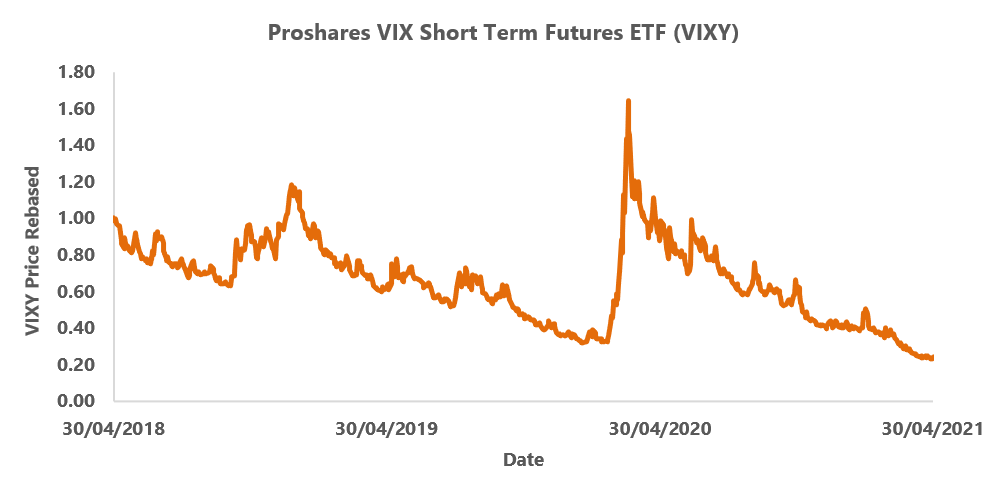
Source: Fortem Capital, Bloomberg
Ideally, there would be an asset class for which the volatility term structure is downward sloping, meaning that one can take a defensive long volatility position while rolling up the curve to earn a premium; the strategy could play the part of both the White & Black Swan. There is one, in long term USD rates:
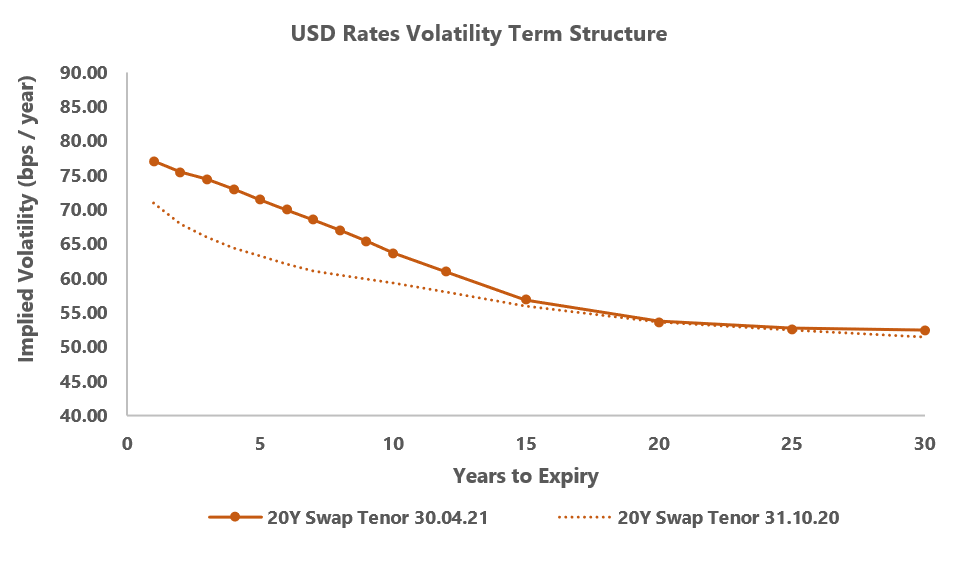
Source: Fortem Capital, Bloomberg
This upward sloping term structure alleviates the issue of bleeding while waiting for turbulence. But, as previously noted, curve strategies in general are susceptible to shifts in curve shape, in this instance to the curve moving into contango. Therefore, one would ideally like there to be a structural reason why the curve is shaped like it is, making it likely to stay that way. There are
two:
Firstly, due to the popularity of Formosas, foreign-issued bonds sold in Taiwan. Their popularity suppresses longer maturity US rates volatility as there is effectively a wall of volatility sellers further out on the curve matching the popular maturities of the Formosas.
Secondly, the vastly reduced size of the MBS market post-GFC means that there is also far less volatility buying as a hedge against pre-payment risk compared to pre-2008.
These are both important structural reasons why the slope is backwardated, and gives an investor confidence to take advantage in the knowledge that the shape is not as a result of short-term macroeconomic drivers, and therefore immune to an extent from macroeconomic shifts.
The Fortem Capital Alternative Growth Fund employs such a strategy, as the particular profile fits neatly into the overall objective of positive uncorrelated returns. The return profile, as a result of the structural difference in the term structure, is entirely different to being long equity volatility:

Source: Fortem Capital, Bloomberg
It is clear that an investor does not suffer the same negative carry as they do when taking on the mighty VIX term structure, while still having a defensive profile that is highly attractive for an uncorrelated Fund. Given that the bond market might well be where the next major turbulence emanates from, the strategy potentially makes more sense than ever.
Careful picking up those pennies.
– This document has been issued and approved as a financial promotion by Fortem Capital Limited for the purpose of section 21 of the Financial Services and Markets Acts 2000. Fortem Capital Limited registration number 10042702 is authorised and regulated by the Financial Conduct Authority under firm reference number 755370.
– This document is intended for Professional Investors, Institutional Clients and Advisors and should not be communicated to any other person.
– The information has been prepared solely for information purposes only and is not an offer or solicitation of an offer to buy or sell the product.
– Data is sourced from Fortem Capital Limited and external sources. The data is as at the date of this document and has been reviewed by Fortem Capital Limited.
– Information, including prices, analytical data and opinions contained within this document are believed to be correct, accurate and derived from reliable sources as at the date of the document. However, no representation or warranty, expressed or implied is made as to the correctness, accuracy or validity of such information.
– Fortem Capital Limited assumes no responsibility or
liability for any errors, omissions or inaccuracy with respect to the information contained within this document.
– All price and analytical data included in this document is intended for indicative purposes only and is as at the date of the document.
– The information within this document does not take into account the specific investment objective or financial situation of any person. Investors should refer to the final documentation and any prospectus to ascertain all of the risks and terms associated with these securities and seek independent advice, where necessary, before making any decision to buy or sell.
– The product may not be offered, sold, transferred or delivered directly or indirectly in the United States to, or for the account or benefit of, any U.S. Person.
– The Fortem Capital Progressive Growth Fund is a Sub-Fund of Skyline, an open-ended investment company with variable capital incorporated on 1 June 2010 with limited liability under the laws of Ireland with segregated liability between Funds. The Company is authorised in Ireland by the Central Bank of Ireland pursuant to the UCITS Regulations.
“NOTICE TO INVESTORS DOMICILED OR RESIDENT IN
SWITZERLAND – The interests in the UCITS Fund and any related services, information and opinions described or referenced in this document are not, and may not be, offered or marketed to or directed at persons in Switzerland (a) that do not meet the definition of “qualified investor" pursuant to the Swiss Federal Act on Collective Investment Schemes of 23 June 2006 (“CISA") (“Non-Qualified Investors"), or (b) that are high net worth individuals (including private investment structures established for such high-net worth individuals if they do not have professional treasury operations) that have opted out of customer protection under the Swiss Federal Financial Services Act of 15 June 2018 (“FinSA") and that have elected to be treated as “professional clients" and “qualified investors" under the FinSA and the CISA, respectively (“Elective Qualified Investors").
In particular, none of the information provided in this document should be construed as an offer in Switzerland for the purchase or sale of the interests or any related services, nor as advertising in Switzerland for the interests or any related services, to or directed at Non-Qualified Investors or
Elective Qualified Investors. Circulating or otherwise providing access to this document or offering, advertising or selling the interests or any related services to Non-Qualified Investors or Elective Qualified Investors may trigger, in particular, approval requirements and other regulatory requirements in Switzerland.
This document does not constitute a prospectus pursuant to Articles 35 et seqq. FinSA and may not fulfill the information standards established thereunder. No key information document pursuant to Swiss law has been established for the interests. The interests will not be listed or admitted to trading on a Swiss trading venue and, consequently, the information presented in this document may not fulfill the information standards set out in the relevant trading venue rules."
For more information on the investment philosophy or any of Fortem’s investment offerings, please do not hesitate to contact the team, we would be delighted to hear from you

 ABOUT
ABOUT